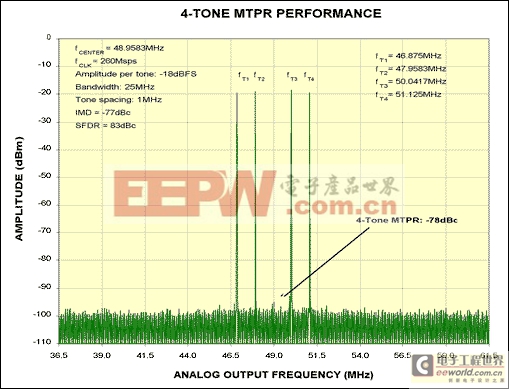关键参数的数模转换器多载波GSM / EDGE的发射机
时间:04-20
来源:互联网
点击:
Intermodulation Distortion (IMD), and Multi-tone power ratio (MTPR)
Other key factors in selecting a DAC for the Tx path of a multi-carrier GSM/EDGE system is the converter's ability to offer superior IMD and MTPR performance. Multiple carriers in a designated band will generate unwanted intermodulation distortion between the individual carrier frequencies. A multi-tone test vector usually consists of several equally spaced carriers, usually four, with identical amplitudes. Each of these carriers is representative of a channel within the defined bandwidth of interest. To verify MTPR, one or more tones are removed such that the intermodulation distortion performance of the DAC can be evaluated. Nonlinearities associated with the DAC will create spurious tones of which some may fall back into the area of the removed tone, limiting a channel's carrier-to-noise ratio. Other spurious components falling outside the band of interest also may be important, depending on the system's spectral mask and filtering requirements. Going back to the GSM/EDGE Tx mask, the IMD specification for adjacent carriers varies somewhat among the different GSM standards. For the PCS1800 and GSM850 standards, the DAC must meet an average IMD of -70dBc.The following table summarizes the dynamic performance requirements for the entire Tx signal chain in a four-carrier GSM/EDGE-based system and compares the previously established converter requirements with a new generation high-dynamic performance DAC.
The 14-bit, 260Msps MAX5195 is the first DAC, which is fully compatible with 4-carrier GSM/EDGE signal generation. It provides excellent dynamic performance and meets all of the GSM/EDGE spectral mask requirements.
The four-tone MTPR plot (Figure 2) demonstrates the DACs superior dynamic performance. The center frequency (fCENTER = 48.9583MHz) has been removed to allow detection and analysis of intermodulation or spurious components falling back into this empty spot from adjacent channels. The four carriers are observed over a 25MHz bandwidth and are equally spaced at 1MHz. The output amplitude has been backed-off by -18dBFS according to the GSM/EDGE spectral mask. Under these conditions, the DAC yields an IMD of -77dBc and an MTPR of -78dBc.

Figure 2. This spectrum plot depicts the four-tone MTPR performance at fCENTER = 48.9583MHz and fCLK = 260MHz of the MAX5195, which meets the most critical GSM/EDGE specifications.
Conclusion
From a system point of view, the ability of the DAC to keep high degrees of dynamic performance under multi-tone conditions, eases the transmitter path design. Traditionally, BTS systems would employ one converter per transmit channel. Now however a DAC with sufficiently high multi-tone performance, will help to simplify the transmitter architecture and reduces board space and cost by cutting down on the number of DACs required in such a system.Notes
1 Single-carrier SFDR observed within a 25MHz window. Although the DAC doesn't meet the SFDR specification completely, a lower single-tone SFDR can be accommodated and compensated for by frequency planning.A similar version of this article appeared in the October 2002 issue of Electronic Products magazine.
模拟电路 模拟芯片 德州仪器 放大器 ADI 模拟电子 相关文章:
- 12位串行A/D转换器MAX187的应用(10-06)
- AGC中频放大器设计(下)(10-07)
- 低功耗、3V工作电压、精度0.05% 的A/D变换器(10-09)
- PIC16C5X单片机睡眠状态的键唤醒方法(11-16)
- 用简化方法对高可用性系统中的电源进行数字化管理(10-02)
- 利用GM6801实现智能快速充电器设计(11-20)
